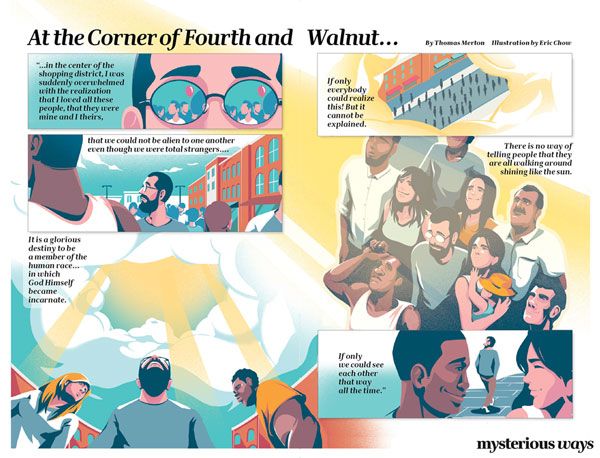On a busy street corner in downtown Louisville, a bronze plaque marks the spot where Christian mystic Thomas Merton changed his way of thinking about himself and the world. “A Revelation,” the plaque reads, “Merton had a sudden insight at this corner, Mar. 18, 1958, that led him to redefine his monastic identity with greater involvement in social justice issues.”
It may seem a strange place to experience a divine epiphany, but truth be told, Merton’s life was punctuated by epiphanies, large and small, all serving to make him one of the world’s greatest writers on faith.
Merton’s spiritual journey is brilliantly delineated in his autobiography, The Seven Story Mountain, a surprise bestseller when it came out in 1948. Born in the south of France to an expatriate artist father and an American mother, he writes about his upbringing in a vivid, faith-filled, decidedly romantic tone, foreshadowing his entry into the Trappist monastery where he would write many of his great works. Yet, he can’t disguise the tragedies and trauma that haunted him.
He did better at Columbia University back in the States, making good friends and excelling academically. Here he found his way, step by step, to faith and a fervent Catholicism.
There could be plaques marking his spiritual evolution in New York City, at Corpus Christi Church in Morningside Heights, where he first went to worship and was baptized. Or at the apartment building on Perry Street in Greenwich Village, where after a late night listening to jazz with friends and a bleary-eyed breakfast, it came to him: “I am going to be a priest.” Talk about unusual moments for epiphanies.
I would be tempted to put up plaques in my own Washington Heights neighborhood. Every morning I jog by a building at 190th Street that used to be St. Elizabeth’s Hospital, where the 25-year-old Merton was treated for appendicitis, grateful for the nuns who cared for him. And I pass the Cloisters Museum, made up of medieval stones brought over from Europe, including an elegant Gothic cloister from a crumbling French monastery not far from where Merton was born.
READ MORE: MY SPIRITUAL RETREAT
Merton was 26 when he entered the Abbey of Gethsemani in Kentucky. It was a sort of renunciation of the world where he had struggled to define his relationship with God, embracing a rigorous life of prayer, penance, work and contemplation instead. From behind those closed walls, Merton reached millions of readers buoyed by his faith and the exuberance of his prose. But his biggest spiritual discovery was yet to come.
He’d been a Trappist monk for seventeen years when he went into Louisville to run some errands and had his “revelation” at the corner of Fourth and Walnut. He suddenly saw the strangers around him in a completely new light.
“It was as if I suddenly saw the secret beauty of their hearts,” he writes of that moment, “the depths of their hearts, where neither sin nor desire nor self-knowledge can reach, the core of their reality, the person that each one is in God’s eyes. If only they could all see themselves as they really are. If only we could see each other that way all the time.”
It was an idea that Merton dedicated himself to for the rest of his life: God wasn’t found away from the world, but in it—he was reflected in every human being. Now that’s an epiphany worth posting on every street corner.






